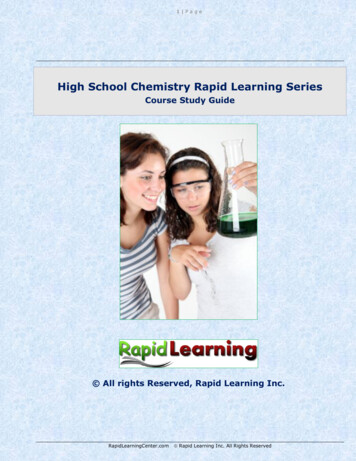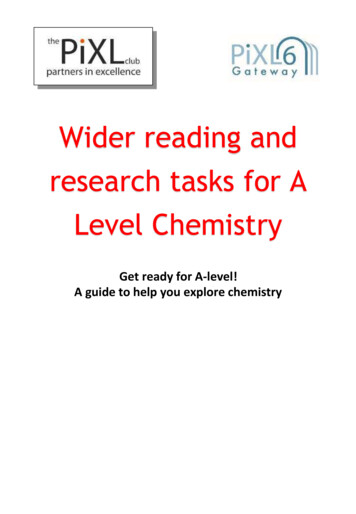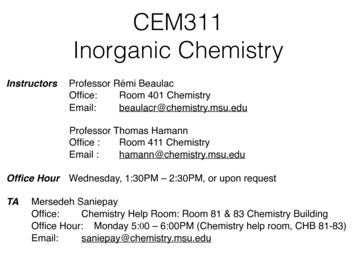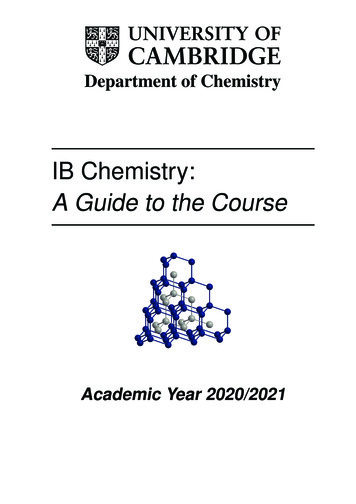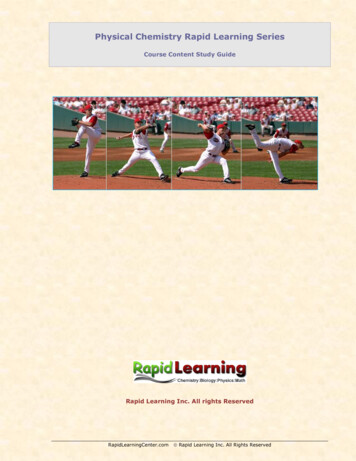
Transcription
Physical Chemistry Rapid Learning SeriesCourse Content Study GuideRapid Learning Inc. All rights ReservedRapidLearningCenter.com Rapid Learning Inc. All Rights Reserved
COURSE TABLE OF CONTENTS – TOPICAL SUMMARYCore Unit #1 – The FoundationTutorial 01: Chemistry and Physics Review for Physical ChemistryBasic Physics ConceptsEnergyClassical MechanicsWavesElectrostaticsBasic Chemistry ConceptsChemical BondingIntermolecular ForcesPhasesChemical ReactionChemical EquilibriumChemical KineticsTutorial 02: Mathematics Review for Physical ChemistryBasic Mathematical Procedures Logarithms and Exponentials Complex Numbers and Complex Functions VectorsCalculus Differentiation and Integration Power Series Partial Derivatives Differential EquationsStatistics and Probability Random Selection Mean Value of a Variable Mean Value of a FunctionMatrix Algebra Matrix Addition and Multiplication Simultaneous EquationsCore Unit #2 – Equilibrium and ThermodynamicsTutorial 03: Zeroth and First Law of ThermodynamicsBasic ConceptsZeroth Law of ThermodynamicsWorkHeatEnergyEnthalpyInternal EnergyRapidLearningCenter.com Rapid Learning Inc. All Rights Reserved
First Law of ThermodynamicsEnergy Flow Processes Expansion Work Heat Flow Enthalpy Change Adiabatic ProcessesThermochemistry Standard Enthalpy Changes Enthalpies of Formation Reaction Enthalpy and TemperatureState Functions and Path Functions Exact Differentials Inexact Differentials Internal Energy Joule-Thompson EffectTutorial 04: Second and Third Laws of ThermodynamicsSpontaneous Change Dispersal of Energy Entropy Second Law of Thermodynamics Entropy Change Heat Capacity Third Law of Thermodynamics Nernst TheoremThe System Helmholtz and Gibbs Energies Standard Gibbs Energies Clausius Inequality Reaction SpontaneityFirst and Second Laws Combined State Functions and Path Functions Internal Energy Gibbs EnergyTutorial 05: Chemical EquilibriumSpontaneous Chemical Change Gibbs Energy Minimum EquilibriumEquilibria and Various Conditions Pressure TemperatureTutorial 06: Phase Equilibrium (Phase Diagrams)Pure Substances Stabilities of Phases Phase Boundaries Phase Diagrams Thermodynamic Equilibrium Phase Stability Phase Boundaries Ehrenfest Classification of Phase TransitionsMulti-Component SystemsRapidLearningCenter.com Rapid Learning Inc. All Rights Reserved
Phase Rule Experimental ProceduresTwo-Component Systems Vapor Pressure Diagrams Temperature-Composition Diagrams Liquid-Liquid Phase Diagrams Liquid-Solid Phase DiagramsTutorial 07: Equilibrium ElectrochemistryElectrochemistry Half-Reactions and Electrodes Electrochemical cells Electromotive Force Standard PotentialsApplications of Standard Potentials Electrochemical Series Activity Coefficients Equilibrium Constants Species-Selective Electrodes Thermodynamic FunctionsTutorial 08: Thermodynamics of Biochemical ReactionsReview of Thermodynamics Enthalpy, Internal Energy, Work and Heat Spontaneity, Disorder and Entropy Gibbs Energy and Maximum Non-PV Work Equilibrium Constants Standard Gibbs Energy ChangeBiological Standard StateThermodynamics of LifeThermodynamics of Transport Membrane Potential Electrochemical PotentialEnergy Conversion in Cells Glycolysis Citric Acid Cycle Respiratory Chain Oxidative PhosphorylationPhotosynthesis PhotophosphorylationCore Unit #3 – Quantum ChemistryTutorial 9: Quantum Mechanics I: Introduction and PrinciplesOrigins Why is Quantum Mechanics Needed? Wave Particle DualityMicroscopic Systems Schrodinger Equation Born Interpretation of WavefunctionPrinciples Information in a WavefunctionRapidLearningCenter.com Rapid Learning Inc. All Rights Reserved
Uncertainty PrinciplePostulatesTutorial 10: Quantum Mechanics II: Techniques and ApplicationsParticle Motion Particle in a Box TunnellingVibration Energy Levels WavefunctionsRotation Two Dimensional Three DimensionalPerturbation Theory Time Independent Time DependentTutorial 11: Atomic Structure and BondingOne-Electron Atoms Structure Orbitals Selection RulesMany-Electron Atoms Orbitals Self-Consistent FieldSpectra Singlet States Triplet States Spin-Orbit Coupling Term Symbols Selection RulesTutorial 12: Electronic Structure and BondingChemical Bonding Theory: Born-Oppenheimer ApproximationValence-Bond Theory Homonuclear Diatomic Molecules Polyatomic MoleculesMolecular-Orbital Theory Hydrogen Molecule-ion Homonuclear Diatomic Molecules Heteronuclear Diatomic MoleculesMolecular Orbitals for Polyatomic Molecules Huckel Approximations Computational Chemistry Prediction of Molecular PropertiesTutorial 13: Molecular Symmetry and Group TheorySymmetry Elements of Structures Symmetry Operations and Elements Symmetry Classification of MoleculesRapidLearningCenter.com Rapid Learning Inc. All Rights Reserved
Symmetry: Character Tables Matrix Representations Irreducible Matrix Representations Character TablesSymmetry: MO Theory and Spectroscopy Vanishing Integrals and Orbital Overlap Vanishing Integrals and Selection RulesTutorial 14: Statistical ThermodynamicsDistribution of Molecular States Configurations and Configuration Weights Molecular Partition FunctionInternal Energy and Entropy Internal Energy Statistical EntropyCanonical Partition Function Canonical Ensemble Information in Partition Function Helmholtz Energy Pressure Enthalpy Gibbs EnergyMolecular Partition Functions Translational Portion Rotational Portion Vibrational Portion Electronic Portion Combined Partition FunctionCore Unit #4 – Molecular SpectroscopyTutorial 15: Rotational and Vibrational SpectroscopyGeneral principles of Molecular Spectroscopy What is the electromagnetic spectrum? Classical view Quantum mechanical viewExperimental Techniques of Molecular Spectroscopy Factors affecting spectral-line intensities Factors affecting spectral-line widths Absorption Spectra Emission Spectra Raman SpectraMolecular Pure Rotational Spectra Moments of Inertia The Rigid Rotor Approximation Linear Rotors Symmetric Rotors Spherical Rotors Degeneracy's of Rotational Energy Levels Rotational Transition Selection Rules Rotational Transition Selection RulesMolecular Vibrational Spectra Molecular VibrationsRapidLearningCenter.com Rapid Learning Inc. All Rights Reserved
Vibration-Rotation Spectra of Diatomic MoleculesVibrational Raman Spectra of Diatomic MoleculesVibrations of Polyatomic MoleculesTutorial 16: Electronic Spectroscopy of MoleculesCore Issues of Electronic Spectroscopy of Molecules Spectral-line intensity Absorption Spectra Emission Spectra Franck-Condon Principle Resolution of Vibrational and Rotational StructureSpectra of Diatomic Molecules Electronic-State Term Symbols Angular Momentum Selection RulesSpectra of Polyatomic Molecules Chromophores d-d Transitions Charge-Transfer Transitions Electronic Excited States Fluorescence Phosphorescence Models Dissociation PredissociationTutorial 17: Laser, Laser Spectroscopy and PhotochemistryGeneral principles of Lasers Stimulated Emission Pumping Three-Level Laser Four-Level vs Three-Level Laser Laser Medium and Cavity Resonant Modes Coherence of Laser beam Pulsed Laser: Q-Switching Pulsed Laser: Mode LockingSolid-State Lasers The Ruby Laser The Neodymium LaserGas Lasers Carbon Dioxide Helium-Neon Argon-Ion LaserExciplex/Eximer LasersChemical LasersDye lasersApplications of Lasers in Chemistry High-Photon-Flux Spectroscopy Raman Spectroscopy Photochemistry Isotope Separation Pulse Techniques Time-Resolved SpectroscopyPhotoelectron SpectroscopyRapidLearningCenter.com Rapid Learning Inc. All Rights Reserved
UPS and XPSEnergies of Molecular OrbitalsTutorial 18: Nuclear Magnetic Resonance SpectroscopyMagnetic Resonance Principles NMR Principles Nuclear Magnetic Energy States NMR Spectrometer Chemical Shift NMR Fine Structure Coupling ConstantPulse NMR Techniques Magnetization Vector Spin Relaxation Nuclear Overhauser Effect, NOE 2D NMR Correlation Spectroscopy, COSY 2D Nuclear Overhauser Spectroscopy, NOESY Solid State NMRElectron Paramagnetic Resonance, EPRCore Unit #5 – Kinetics and DynamicsTutorial 19: Kinetic Theory of Gases and Transport ProcessesKinetic Theory of Gases Assumptions of the Kinetic Theory Elastic Collision Total Momentum change Root Mean Square Speed Pressure Kinetic Energy Root Mean Square Speed Maxwell Distribution of Speeds Intermolecular Collision Frequency Mean Free PathTransport Processes of Gas Molecules Collision flux Frequency of Collisions with Surface Diffusion Thermal Conduction ViscosityTutorial 20: Chemical Kinetics I: Rate LawsRate Laws Differential Rate Laws Integrated Rate Laws Zero Order Integrated Rate Law 1st Order Integrated Rate Law 2nd Order Integrated Rate Law Graphing Integrated Rate LawsHalf-LifeThe Arrhenius Equation Temperature Dependence of Rates Reaction Coordinate Diagram Activated Complex Activation EnergyRapidLearningCenter.com Rapid Learning Inc. All Rights Reserved
Elementary Reactions Molecularity Molecularity v.s. Reaction Order Consecutive Elementary Reactions Rate-determining Step Steady-state Approximation Equilibrium Pressure-dependant Unimolecular Reaction Lindemann-Hinshelwood MechanismTutorial 21: Chemical Kinetics II: Reaction Mechanisms Natural SelectionReaction Mechanisms Rate Determining StepChain Reactions Steps of Chain Reactions Rate Laws of Chain ReactionsExplosionsPhotochemical Reactions Steps of Photochemical Reactions Number of Photons Quantum Yield Photochemical rate laws Photosensitization QuenchingPolymerization Kinetics Chain Polymerization Step PolymerizationCatalysis Types of Catalysis Autocatalysis Oscillating Reactions Enzymes Michaelis-Menten MechanismTutorial 22: Molecular Reaction DynamicsCollision Theory Collisions Must Occur Collisions Frequency Energy Factor in Reaction Rate Fraction of Effective Collisions Collisions with Correct Orientation The Integrated Equation Estimate Rate ConstantDiffusion-controlled Reactions Reactions in Solution Cage Effect Diffusion-Controlled Vs Activation-Controlled Stokes-Einstein EquationActivated Complex Theory Reaction Profile Activated Complex (Transition State) Mechanics of Activated Complex Theory Decay of the Activated Complex Reaction Coordinate Concentration of Activated ComplexRapidLearningCenter.com Rapid Learning Inc. All Rights Reserved
Equilibrium Constant Partition Function Eyring EquationThermodynamics of Activated Complex Theory Activation Parameters Arrhenius EquationPotential Energy Surfaces Saddle PointsTutorial 23: The Solid State and Surface ChemistryCrystal Lattices Lattices and Unit Cells Lattice Planes X-Ray DiffractionBonding in Solids Metallic Bonding in Solids Ionic Bonding in Solids Covalent Network Bonding in Solids Molecular SolidsSolid Surfaces Solid Surface Composition Physisorption and Chemisorption on Solids Solid Surface Catalysts Redox at Solid SurfacesCore Unit #6 – Physical Chemistry ExperimentsTutorial 24: The Guide to Physical Chemistry LabsPreparing for Laboratory Study/Review Experiment and Related Chemistry Prepare notebook and write Introduction Obtain and Review MSDS’s for all Chemicals Identify and Plan for Safety ConcernsConducting Experiment Setting-up and Calibrating Instrumentation/Equipment Making Measurements and Recording DataAnalyzing Data Rejecting Bad Data Performing Calculations Based on Good Data Tabulating and Graphing ResultsLaboratory Report Introduction Method Results DiscussionRapidLearningCenter.com Rapid Learning Inc. All Rights Reserved
COURSE FEATURESThis tutorial series is a carefully selected collection of core concept topics that cover theessential concepts. It consists of three parts:1. Concept Tutorials – 24 essential topics2. Problem-Solving Drills – 24 practice sets3. Super Condense Cheat Sheets – 24 super review sheetsCore Tutorials Self-contained tutorials, not an outline of information which would need to besupplemented by an instructor. Concept map showing inter-connections of new concepts in this tutorial and thosepreviously introduced. Definition slides introduce terms as they are needed. Visual representation of concepts. Conceptual explanation of important properties and problem solving techniques A concise summary is given at the conclusion of the tutorial.Problem Solving Drills Each tutorial has an accompanying Problem Set with 10 problems covering thematerial presented in the tutorial. The problem set affords the opportunity to practicewhat has been learned.Condensed Cheat Sheet Each tutorial has a one-page cheat sheet that summarizes the key concepts andvocabularies and structures presented in the tutorial. Use the cheat sheet as a studyguide after completing the tutorial to re-enforce concepts and again before an exam.RapidLearningCenter.com Rapid Learning Inc. All Rights Reserved
CHAPTER BY CHAPTER DETAILED CONTENT DESCRIPTIONS01: Chemistry and Physics Review for Physical ChemistryChapter SummaryThis chapter reviews the basic physical and chemical concepts used in Physical Chemistry.Tutorial Features Concept map showing inter-connections of concepts.Definition slides introduce terms as they are needed.Examples given throughout to illustrate how the concepts apply.A concise summary is given at the conclusion of the tutorial.Core Issues of Basic Chemistry and Physics Energy Classical Mechanics Waves Chemical Bonding Intermolecular Forces Phases Chemical Reaction Chemical Equilibrium Chemical KineticsChapter Review There are two types of energy: Kinetic and Potential. Kinetic Energy is associated withmotion and is calculated as one-half the mass of an object multiplied by velocity squared. Potential Energy is the force acting on an object multiplied by the distance over whichthe force acts. The force on an object is associated with location. As a result potentialenergy is associated with location. Classical Mechanics predicts that if the initial position and momentum of an object freefrom outside forces are known, all future positions and momenta may be calculated. Disturbances that travel through space are Waves. Disturbances (waves) in Electromagnetic Radiation are oscillating Electric and MagneticFields. Chemical bonds are the forces that hold atoms together in molecules and ionic solidsand liquids. Chemical bonds are strong forces between atoms referred to as CovalentBonds or Ionic Bonds. Intermolecular forces (forces between molecules) are weaker forces than chemical bondsand are referred to as Van der Waals forces in honor of Johannes Van der Waals. Most chemicals may exist in solid phases, liquid phases or a gas phase depending on thetemperature, pressure and presence of other chemicals. A chemical reaction takes place when one set of chemicals (reactants) interact and changeinto another set of chemicals (products).RapidLearningCenter.com Rapid Learning Inc. All Rights Reserved
A chemical reaction is at equilibrium when the forward reaction rate, from left to right, isequal to the reverse reaction rate, from right to left. The rate or speed of a chemical reaction is expressed in terms of the rate of formation ofa product or the rate of use of a reactant. The rate or speed of a chemical reaction is determined by the activities/concentrations ofthe reactant species and temperature. Chemical reactions take place as a result of random collisions of chemical species. Most chemical reactions require a series of collision processes, steps, and often one of thesteps is much slower and determines the rate of the reaction.RapidLearningCenter.com Rapid Learning Inc. All Rights Reserved
02: Math Review for Physical ChemistryChapter SummaryPhysical-Chemical principles and related insights result from mathematical analysis ofChemical data. Clear understanding of Mathematics is essential to understanding PhysicalChemistry. This chapter is a review of much of the mathematics of Physical Chemistry.Tutorial Features Concept map showing inter-connections of concepts.Definition slides introduce terms as they are needed.Examples given throughout to illustrate how the concepts apply.A concise summary is given at the conclusion of the tutorial.Core Issues of Math for Physical Chemistry Basic Mathematical ProceduresoLogarithmsoExponentialsoComplex NumbersoVectorsCalculusoooo Statistics and Probabilityooo DifferentiationIntegrationPartial DerivativesDifferential EquationsRandom SelectionMean Value of a VariableMean Value of a FunctionMatrix AlgebraoooMatrix additionMatrix MultiplicationSimultaneous EquationsChapter Review The Common Logarithm of a number x is the power to which 10 must be raised to havethe value x. The Natural logarithm of a number x is the power to which e must be raised to have thevalue x. Exponential functions occur often in chemical calculations. An Exponential Function includes a base raised to a power. A product of Exponential Functions is the base raised to the power of the sum of theexponents of the Exponential Functions. A quotient of Exponential Functions is the base raised to the sum of the exponents of theExponential Functions in the numerator minus the sum of the exponents of theExponential Functions in the denominator. An Exponential Function raised to a power is the base raised to the product of the powers.RapidLearningCenter.com Rapid Learning Inc. All Rights Reserved
Complex Numbers include the square root of -1 as a factor. The general format for acomplex number is factored into a real part and an imaginary part. A Vector is a quantity that has both direction and magnitude. Unit Vectors i, j, and k have a magnitude of 1 and convert magnitudes into vectorcomponents along their respective directions: x, y, and z. Vectors may be added and/or subtracted by adding and/or subtracting their component;x, y, and z, magnitudes. Vectors may be multiplied as either cross-products or scalar-products. The slope of a function at a point is the derivative of the function at that point. A ratio of differentials is a derivative. An infinitesimal change in a function or variable is a differential. The process of obtaining a derivative is differentiation. Derivatives of functions are obtained by referring to Tables of Derivatives available incalculus texts, math reference books and on the internet. Determining the derivative of a function having more than one independent variable,when all but one independent variable is held constant is partial differentiation. A partial derivative is obtained using the same process as an ordinary derivative, exceptthat all but one of the independent variables is held constant. Notation for a partial derivative list all variables held constant in a right-hand subscript. Adding together, summing, an infinite number of differentials is Integration. A Table of Integrals is used to obtain integrals of common functions. Integration between limits, from A to B, is a definite integral. A differential equation is an algebraic equation that includes derivatives. Problems in Chemistry and Physics are commonly able to be expressed in terms ofDifferential Equations. Solving a differential equation means finding the function or functions that fit theequation. The most probable behavior of a system of molecules is determined by calculating thenumber of ways that a particular distribution of the molecules, among the quantum statesof the system, may occur. The number of ways that a particular distribution of the molecules, among the quantumstates of a system, may occur is W. The mean value of a variable is calculated from the probabilities of occurrence of thepossible values of the variable. A Matrix is a rectangular array of numbers, Elements of the matrix. Matrix-Element symbols give the row number followed by the column number as a righthand subscript. Matrices are added to give a sum matrix C by adding the corresponding elements of thesummed matrices A and B. Two Matrices may be multiplied if the number of rows in the first matrix is equal to thenumber of columns in the second matrix. Matrices are multiplied to give a product matrix C by multiplying corresponding elementsof a row of the matrix A by the elements of the corresponding column of matrix B andsumming these to give product matrix elements. When the conditions for a set of equations are met simultaneously, the equations arecalled Simultaneous Equations.RapidLearningCenter.com Rapid Learning Inc. All Rights Reserved
03: Zeroth and First Law of ThermodynamicsChapter SummaryThe Zeroth Law of thermodynamics is the basis for the design and use of thermometers. Thefirst law of thermodynamics makes possible the combination of heat flow and mechanicalwork to give the total internal energy change for a process.Tutorial Features Concept map showing inter-connections of concepts.Definition slides introduce terms as they are needed.Examples given throughout to illustrate how the concepts apply.A concise summary is given at the conclusion of the tutorial.Key Concepts Zeroth LawWorkHeatEnergyFirst LawInternal EnergyExpansion WorkEnthalpyAdiabatic ProcessesStandard Enthalpy ChangesReaction Enthalpy and TemperatureExact and Inexact DifferentialsJoule-Thompson EffectChapter Review The Zeroth Law of Thermodynamics states that if systems in a physical-chain of systemsare in thermal equilibrium with their neighboring systems then they are in thermalequilibrium with all members of the chain of systems. Heat is energy flow from a hotter object to a cooler object when the two are in thermalcontact. Work, w, is done on a system when a force is exerted on a system, as by steam on thepiston of the steam engine below, causing a displacement. Work, w, and Heat Flow, q, are energy transfer processes. A system has an amount of energy, not an amount of work or heat. Heat flow for a system, q, is calculated by multiplying the heat capacity, C, for the systemby its temperature change, T. Work is calculated by multiplying a driving force, F, by distance driven, d, Force xDistance, F x d, or other equivalent products such as Pressure x Volume Change, P x V. The Internal Energy of a system is stored in a number of forms: molecular electronic,vibrational, rotational and translational energy. Internal Energy, U, does not include energy of motion through space of a whole system. The First Law of Thermodynamics states that Internal Energy change for a system is thesum of work and heat flow for the system. A gas flowing into a vacuum such as gases leaking, expanding, into the vacuum of Space,a Free Expansion does not perform any work, because there is no resisting pressure.RapidLearningCenter.com Rapid Learning Inc. All Rights Reserved
Work done by reversible expansion with higher, equilibrium, gas pressures leads to alarger amount of work. A very slow expansion/contraction process will be at equilibrium (reversible) at all times. The work done by reversible/equilibrium expansion of a system is the greatest amount ofwork possible for that expansion. The Ice Calorimeter is one of several types of Calorimeters used for measuring HeatFlow. An Adiabatic Bomb Calorimeter has a very strong container, Bomb, inside of which aheat-flow process, such as a chemical reaction, takes place at constant Volume. Enthalpy (H) is the sum of Internal Energy U and Pressure times Volume: H U PV. Enthalpy, pressure, volume and Internal Energy are all State Functions. A State Function depends only on the State/Condition of a System and not on theprocesses which lead to the state. An Adiabatic process has no heat flow between system and surroundings. Enthalpies of Standard formation Reactions are available in reference sources. Hess’s Law is applied to Standard Formation Reactions to obtain Standard ReactionEnthalpies. The Chemical Product in a Standard Formation Reaction is one mole of the chemical beingformed. Reactants in Standard Formation Reactions are elements in their most stable form at thereference temperature. Variables that depend only on the condition/state of a system and not on the path/mannerby which the state was created are State Functions and have exact differentials. Exact differentials may be integrated along any path between two states with the sameresult for each path. The Joule-Thompson Effect is the cooling of gases when they expanded at constantEnthalpy, H.RapidLearningCenter.com Rapid Learning Inc. All Rights Reserved
04: Second and Third Law of ThermodynamicsChapter SummaryThe Second Law of Thermodynamics Introduces the State Function Entropy (S). Entropy is ameasure of the degree to which energy is dispersed. Entropy increases as energy is morewidely distributed/dispersed. The Third Law of Thermodynamics describes what happens toEntropy when the Absolute Zero of Temperature is reached. In the case of a perfectcrystalline material the entropy becomes zero.Tutorial Features Concept map showing inter-connections of concepts.Definition slides introduce terms as they are needed.Examples given throughout to illustrate how the concepts apply.A concise summary is given at the conclusion of the tutorial.Key Concepts Dispersal of Energy Entropy and Second Law Entropy Change Third Law Helmholtz and Gibbs Energies Standard Gibbs Energies Internal Energy Gibbs EnergyChapter Review: Analysis of spontaneous processes in Isolated Regions of the Universe yield a simple fact:all spontaneous processes lead to great dispersal of energy and/or matter within anIsolated Region. An Isolated Region Isolated (System Surroundings) does not exchange energy ormaterial with the remainder of the Universe. Processes, such as phase transitions or chemical reactions that lead to more even/randomdistribution of material and/or energy within an Isolated Region of Universe tend to bespontaneous. Mathematical analysis of Spontaneous Processes leads to a new Thermodynamic Function,Entropy, and the Second Law of Thermodynamics. Solid or liquid phases evaporating to gases or transfer of energy from high temperatureregions to lower temperature regions are examples of spontaneous processes in isolatedregions of the Universe. The Second Law of Thermodynamics formalizes the understanding of spontaneousprocesses with the definition of a thermodynamic quantity called Entropy, S. Entropy change is defined in terms of a differential, infinitesimal, change in Entropy. To determine an Entropy change it is necessary to find a reversible path between theinitial and final states for the process and to integrate, dS, along that path. A Thermodynamic Temperature Scale, Kelvin, was defined by Lord Kelvin of Scotland interms of the efficiency of an ideal reversible heat engine. The Third Law of Thermodynamics: The entropy of all perfect crystalline substances iszero at 0K. The Kelvin temperature scale defines a zero of temperature as the temperature at whichthe efficiency of an ideal heat engine is unity. Nernst Theorem: the entropy changeRapidLearningCenter.com Rapid Learning Inc. All Rights Reserved
accompanying any physical or chemical process approaches zero as the temperatureapproaches 0K provided all the substances involved are perfectly crystalline.Entropy is shown to be a state function by demonstrating that it has zero change over anycyclic path, beginning and ending with the same arbitrary state.Helmholtz and Gibbs Energies are state functions defined for the purpose of determiningprocess spontaneity solely on the states of a system, rather than on both system andsurroundings.In words, the Gibbs Energy change for a process at constant temperature and pressure isnegative for spontaneous processes.Gibbs Energy changes for combustion and formation reactions under standard conditionsare available in text books and in the NIST Chemistry d Conditions, Standard State, for reactants and products is a pure chemical at 1bar pressure and, most commonly, a temperature of 298 K.It is common to ignore the small effect of pressure on molar Gibbs energy for condensedphases unless pressure changes are large as in some Geological environments. G values for solids and liquids caused by pressure changes are small due to the smallmolar volumes of these Condensed Phases. G values for solids and liquids caused by pressure changes are small due to the smallmolar volumes of these Condensed Phases.RapidLearningCenter.com Rapid Learning Inc. All Rights Reserved
05: Chemical EquilibriumChapter SummaryThe equilibrium position of a chemical reaction is located by determining the balance ofreactant and product chemical composition that has the lowest/minimum value of GibbsEnergy. Gibbs Reaction Energy is the slope of a plot of Gibbs Energy of Reaction versus theExtent of Reaction, , at constant pressure and Temperature. Gibbs Energy of Reaction isnegative when reactants convert spontaneously to products. Gibbs Energy of Reaction ispositive when products convert spontaneously to reactants. Gibbs Energy of Reaction is zerowhen a reaction is at equilibrium, which occurs when Gibbs energy is at a minimum.Tutorial Features Concept map showing inter-connections of concepts.Definition slides introduce terms as they are needed.Examples given throughout to illustrate how the concepts apply.A concise summary is given at the conclusion of the tutorial.Key Concepts Gibbs Energy MinimumEquilibrium and Gibbs Energy MinimumEquilibrium and Pressure ChangeEquilibrium and Temperature ChangeChapter Review The equilibrium position of a chemical reaction is located by determining the balance ofreactant and product chemical composition that has the lowest/minimum value of GibbsEnergy, G. Gibbs Reaction
Basic Chemistry Concepts Chemical Bonding Intermolecular Forces Phases Chemical Reaction Chemical Equilibrium Chemical Kinetics Tutorial 02: Mathematics Review for Physical Chemistry Basic Mathematical Procedures Logarithms and Exponentials Complex Numbers and Complex Functions Vectors Calculus

